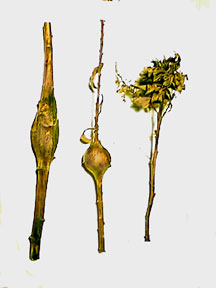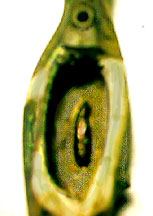Goldenrod Galls

[View from microscope of a hole in an elliptical goldenrod gall]
The elliptical gall is created by the larva of a moth (Gnorimoschema
gallaesolidaginis) called the goldenrod gall moth. Donald Stokes in A Guide to Nature
in Winter relates that the moth lays it's eggs on the goldenrod in the fall. The eggs
hatch out in the spring and then larva finds a new growing goldenrod and burrows into
the stem where it develops during the summer unless some other insect, such as an
ichneumon wasp, lays its eggs in the moth larva and kills it. In any case, the
elliptical gall is usually empty by late summer unless, or until, some other insect
crawls in for protection. Something interesting to look for is the size and shape of
the opening in the gall. The moth grub, according to Anna Comstock in Handbook of
Nature Study, cuts a bevelled oval hole before pupating. The grub fills the hole
with silk and plant parts. Because the bevel is toward the outside, it's easy for
the emerging moth to push its way out but very difficult for any other insect to push
the filling in before the moth emerges. If all goes well, the winter gall may only
contain the red-brown pupal skin of the moth. Other winter findings, according to Donald
Stokes, may be remains of wasp cocoons, spider egg cases, bees, ants, beetles, or
thrips.
(The gall which I opened contained only the red-brown pupal skin of the moth.)
[View of an opened elliptical goldenrod gall] An internet source from Carleton University states that the goldenrod gall moth grub overwinters in the gall. Perhaps the life cycle still needs more study? The spherical goldenrod gall is made by the goldenrod gall fly (Eurosta solidaginis). The spherical gall is occupied during the winter by the grub of the goldenrod gall fly unless some preditor had eaten or destroyed it. Preditors, according to various sources, include downy woodpecker, black-capped chickadees, grey squirels, two types of wasps, one beetle species and inquisitive naturalists.
[View through microscope of goldenrod gall fly grub] According to a web page article by Doug Collicutt, the goldenrod gall fly is a poor flyer and, after hatching in the spring, tends to walk to new goldenrod plants to lay its eggs. One will find spherical goldenrod galls clumped into fairly small areas according to this informtion. He states that the flies only live a couple of weeks during which they mate and lay eggs in goldenrods for the cycle to continue. The goldenrod bunch gall is formed by a midge (Rhopalomyia solidaginis). According to Donald Stokes, the bunch gall is only on the Canada goldenrod (Solidago canadensis). He also states that the bunch gall is formed by only one midge grub but that other species' grubs may share the shelter of the bunch gall. Notes and photographs by D. Gugler - February 10, 2002 More Information on Goldenrod Galls
Doug Collicutt at Nature North
Dean A. Gugler
|


